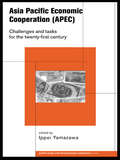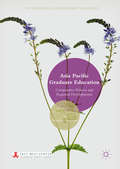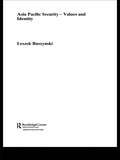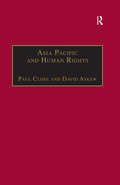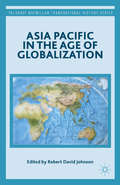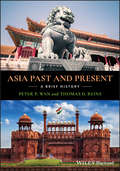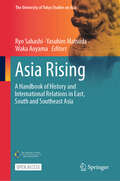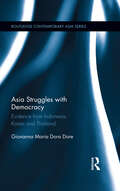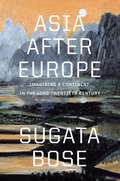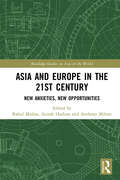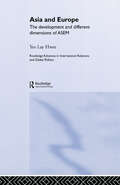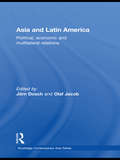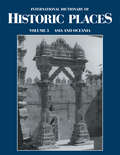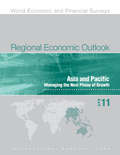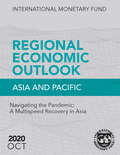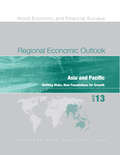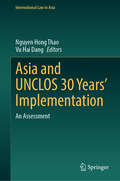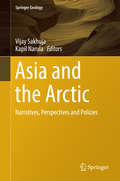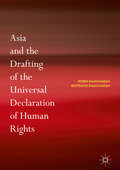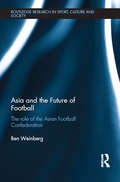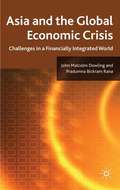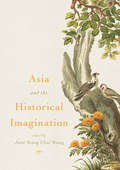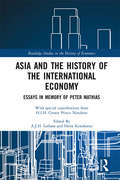- Table View
- List View
Asia Pacific Economic Cooperation: Challenges and Tasks for the Twenty First Century (PAFTAD (Pacific Trade and Development Conference Series))
by Ippei YamazawaThis book provides the most up-to-date and comprehensive account of the APEC (Asia Pacific Economic Cooperation) organisation and examines the challenges APEC now faces in the new century. Subjects covered include:* the history of APEC* APEC and the latest WTO round* case-studies of countries in the region including China, Japan, Malaysia, Korea and Taiwan* APECs approach to competition and deregulation policy* assessment of APECs standing as an international institutionFeaturing contributions from distinguished groups of international academic experts, this book is essential reading for all those interested in political and economic developments in the Asia-Pacific.
Asia Pacific Graduate Education: Comparative Policies and Regional Developments (International and Development Education)
by Deane E. Neubauer Prompilai BuasuwanThis volume examines the changes taking place within graduate education in the Asia Pacific Region. A collection of essays by distinguished scholars from eight Asia Pacific nations links profound changes occurring in the economies and societies of the region to the many changes taking place within higher education. Focusing on how the dynamics of a changing global economy are affecting the ways higher education institutions are responding, particular changes are seen to be taking place in graduate education as many societies experience the need to produce graduates of high quality with elevated qualifications. Such changes are not without challenge or difficulty as issues of finance. Questions of appropriate directions of innovation and overall higher education capacity continue to frame the broader issue of the changing nature of graduate education.
Asia Pacific Security - Values and Identity (Routledge Security In Asia Ser.)
by Leszek BuszynskiThe main theme of this book is that security is not just about defence from external attack, but embraces the protection of identity and values which cultures regard as important, and which they may regard as worth fighting for. It examines Asia Pacific security from the perspective of the values and identities of the major actors in the region - C
Asia Pacific and Human Rights: A Global Political Economy Perspective (New Regionalisms Series)
by Paul Close David AskewHuman rights are acquiring an increasingly prominent role on the world stage. Interest in, concern about and action on human rights are widespread and rising, albeit in a far from globally even, uniform and untroubled fashion. Human rights have generated a booming global industry while having become, not unconnectedly, highly controversial and deeply contested. Human rights matters have emerged as a major source of disagreement, dispute and discord at and between the local, regional and global levels of social, cultural, political and economic life. These developments are addressed in the book by an examination of the links between the evolving global human rights regime (GHRR) and the character and course of human rights in the world's most dynamic, complex and problematic region, that of the Asia Pacific. The authors argue that although the Asia Pacific and human rights nexus is influenced by cultural clashes, it is largely shaped by power distributions and struggles rooted in the global political economy (GPE). The prevailing GHRR reflects the way in which globalization processes have been Western led, but its future is far from certain given the current shift in the balance of GPE power towards the Asia Pacific, and especially East Asia.
Asia Pacific in the Age of Globalization (Palgrave Macmillan Transnational History Ser.)
by Robert David JohnsonThe essays in this volume examine United States-East Asian relations in the framework of global history, incorporating fresh insights that have been offered by scholars on such topics as globalization, human rights, historical memory, and trans-cultural relations.
Asia Past and Present: A Brief History
by Peter P. Wan Thomas D. ReinsA wide-ranging introduction to the multi-faceted history of Asia—from early origins to the present Asia Past and Present is an expansive survey of the social, political, and economic history of the continent from the Paleolithic era to the early 21st century. As there is no physically discrete continent, rather an arbitrary division of the Eurasian landmass, this book focuses on terrain that encompasses India, Pakistan, Afghanistan, Central Asia, China, Korea, Japan, Mongolia, the Russian Far East, and Southeast Asia—the area which most modern scholars identify as Asia. Offering broad chronological and topical coverage of Asia, this book examines subjects including written languages, religions and philosophies, concepts of monarchy, militarism, independence and nation building, and more. Particular focus is placed on the varying levels of influence the core cultures of India and China have had on the continent in a multitude of socio-political areas. Historical dialogues of how colonies, later emerging nations, blended traditional Asian culture and Western political and economic models of modernization complement contemporary discussions of globalization, nuclear tensions, and growing demands for greater individual freedom. Written in an engaging, accessible style, this book: Covers of a wide range of topics, perspectives, geographic regions, and time periods Highlights India and China as the pre 19th century cultural cores of Asia Presents a relatable political-cultural narrative framework Discusses contemporary themes including gender, sexual orientation, the environment, and Western and Islamic influence on Asian culture Includes coverage of commonly underrepresented regions such as the Himalayan nations, Maldives, and New Guinea Asia Past and Present: A Brief History is a valuable resource for undergraduate courses where Asian cultures are introduced, and in courses on Asian politics, diplomacy, environmental issues, and socio-economics.
Asia Renal Care
by Michael J. RobertsPresents a business plan for a start-up company focused on building a network of high-quality dialysis centers in the Asia-Pacific region. Includes a detailed financial forecast. Students have the opportunity to run various roll-out strategies and focus on different Asian countries. Teaching purpose: To allow students to better understand the financial and economic underpinnings of the business.
Asia Rising: A Handbook of History and International Relations in East, South and Southeast Asia (The University of Tokyo Studies on Asia)
by Ryo Sahashi Yasuhiro Matsuda Waka AoyamaThis open-access book offers a clear and thorough exploration of Asia's history from an international relations perspective. The book investigates key political, economic, and cultural forces defining Asia. It highlights the historical and current significance of the Indo-Pacific region, particularly shedding light on its strategic role in global geopolitics. Through detailed historical analyses, the authors guide readers toward a comprehensive understanding of Asia's complex international relations, from colonization and imperialism, through the Cold War, into decolonization and the wave of democratization in the region, to the rise of China, unpacking the various dimensions of regionalism in Asia. This book serves as a practical scholarly resource for advanced students, researchers, and lecturers interested in understanding the region's past and its implications for future geopolitical dynamics. It is relevant to historians focused on Asia and to international relations and political science scholars interested in the shift to an Asian world order, from past to present.
Asia Rising: A Sectoral Perspective
by Florence Jaumotte Nikola SpataforaA report from the International Monetary Fund.
Asia Struggles with Democracy: Evidence from Indonesia, Korea and Thailand (Routledge Contemporary Asia Series)
by Giovanna Maria DoreSince 1974, when the current wave of democratisation began, the movement towards democracy in Asia has remained limited. Many countries in Asia, in fact, are not making a decisive move towards democracy, and find themselves struggling with the challenges of democratic consolidation and governance. Focusing on Indonesia, Thailand and Korea, this book analyses why democratisation is so difficult in Asia. The book investigates the dynamics by which citizens embrace democratic rule and reject authoritarianism, and also compares these dynamics with those of consolidating democracies around the world. The book looks at the forces that affect the emergence and stability of democracy, such as elite interactions, economic development and popular attitudes as beliefs and perceptions about the legitimacy of political systems have long been recognised as some of the most critical influences on regime change. The book also discusses what it is about the nature of public opinion and the processes of day-to-day democratic participation that have made these countries vulnerable to repeated crises of legitimacy. Using Indonesia, Korea, and Thailand as case studies, this book highlights the uniqueness of the Asia’s path to democracy, and shows both the challenges and opportunities in getting there. The book will be of interest to students and scholars of Asian Politics, Comparative Politics and International Studies.
Asia after Europe: Imagining a Continent in the Long Twentieth Century
by Sugata BoseA concise new history of a century of struggles to define Asian identity and express alternatives to European forms of universalism.The balance of global power changed profoundly over the course of the twentieth century, above all with the economic and political rise of Asia. Asia after Europe is a bold new interpretation of the period, focusing on the conflicting and overlapping ways in which Asians have conceived their bonds and their roles in the world. Tracking the circulation of ideas and people across colonial and national borders, Sugata Bose explores developments in Asian thought, art, and politics that defied Euro-American models and defined Asianness as a locus of solidarity for all humanity.Impressive in scale, yet driven by the stories of fascinating and influential individuals, Asia after Europe examines early intimations of Asian solidarity and universalism preceding Japan’s victory over Russia in 1905; the revolutionary collaborations of the First World War and its aftermath, when Asian universalism took shape alongside Wilsonian internationalism and Bolshevism; the impact of the Great Depression and Second World War on the idea of Asia; and the persistence of forms of Asian universalism in the postwar period, despite the consolidation of postcolonial nation-states on a European model.Diverse Asian universalisms were forged and fractured through phases of poverty and prosperity, among elites and common people, throughout the span of the twentieth century. Noting the endurance of nationalist rivalries, often tied to religious exclusion and violence, Bose concludes with reflections on the continuing potential of political thought beyond European definitions of reason, nation, and identity.
Asia and Europe in the 21st Century: New Anxieties, New Opportunities (Routledge Studies on Asia in the World)
by Rahul MishraHow are the rising mutual concerns of Asian and European countries shaping their approaches to the international order? Contributors to this volume discuss emerging critical issues in International relations, including the Indo-Pacific constructs, China’s Belt and Road Initiative (BRI), and the progress of established regional security mechanisms like the Shanghai Cooperation Organisation. They also compare western and non-western approaches to these issues, with a holistic perspective on the origins and evolutions of these approaches. Both the Indo-Pacific constructs and BRI present a remarkable set of opportunities for Europe as well as Asia. This book presents key implications of the changing politico-security dynamics in the two regions from the perspectives of both Asian and European scholars and theoretical traditions. A must-read for scholars of International Relations with a focus on relations between Asia and Europe.
Asia and Europe: The Development and Different Dimensions of ASEM (Routledge Advances in International Relations and Global Politics)
by Lay Hwee YeoThis book provides a systematic and thorough examination of the Asia-Europe Meeting (ASEM) process which brings together the fifteen EU member states, the European Commission and ten East and Southeast Asian countries. The author not only traces the actual development of the ASEM process, but also contextualises ASEM within three different international relations theoretical frameworks, as viewed by realists, social constructivists and institutionalists.
Asia and Latin America: Political, Economic and Multilateral Relations (Routledge Contemporary Asia Series)
by Jörn DoschUntil the late 1980s, Japan was the only country in Asia with notable political and economic relations. Since then, however, several Asian nations have perceived growing links with the Latin American region as a means of diversifying their political and particularly economic relations while many Latin American decision-makers have increasingly recognised the strategic importance of East Asia in their foreign policy and foreign economic policy designs. This book analyses the economic, political and socio-cultural relations between Asia and Latin America and examines their growing importance in international relations. In the first part of the book the contributors look at the policies, interests and strategies of individual Asian and Latin American states, while the second part delves into the analysis of multilateral institution-building in Asia-Latin America relations,. As such, Asia and Latin America will be of interest to undergraduate and postgraduate scholars of comparative politics, international relations, Asian politics and Latin American politics.
Asia and Oceania: International Dictionary of Historic Places
by Christopher Hudson Trudy Ring Sharon La Boda Robert M. Salkin K. A. Berney Paul E. SchellingerFrom the Taj Mahal to the Parthenon, from Gettysburg to Heidelberg, from Beacon Hill to Tower Hill, from the Great Wall to Hadrian's Wall, from Jerusalem to Kyoto, the International Dictionary of Historic Places presents some 1,000 comprehensive and fully illustrated histories of the most famous sites in the world. Entries include: location, description, and site office details; and a 3,000 to 4,000 word essay that provides a full history of the site and the condition of the site today. An annotated Further Reading list of books and articles about the site completes each entry.
Asia and Pacific Managing the Next Phase of Growth
by International Monetary FundThe April 2011 issue of the Regional Economic Outlook: Asia and Pacific focuses on the policy challenges of managing the next phase of growth after Asia's recovery from the global crisis. The analytical chapters discuss how capital flows To The region may affect the monetary policy transmission mechanism And The role of macroprudential measures in this context, The implications of the Asian supply chain for rebalancing growth across the region, And The policy challenges for Asian low-income and Pacific Island countries. Economic recovery in Asia as a whole has been rapid (8. 3 percent in 2010) and fueled by both exports and domestic demand. Looking ahead, growth is expected to continue at a more moderate but also more sustainable pace in 2011 and 2012, led by China and India. Meanwhile, new risks To The outlook have emerged. The full human cost and impact on infrastructure of the mid-March earthquake and tsunami in Japan remain to be determined. The steady response of the Japanese government and people has helped to contain the effects of the disaster on production, but a risk remains of prolonged disruptions in production that could spill over to other Asian economies in the regional supply chain. Moreover, tensions in the Middle East and North Africa and related risk of further oil price spikes could disrupt global growth and affect Asian exports. Finally, pockets of overheating have emerged in Asia, As core inflation and credit growth have accelerated in several Asian economies. The need to tighten macroeconomic policy stances has become more pressing than it was six months ago.
Asia and Pacific-Navigating the Pandemic: Navigating The Pandemic: A Multispeed Recovery In Asia
by International Monetary FundA report from the International Monetary Fund.
Asia and Pacific: Shifting Risks, New Foundations for Growth
by International Monetary FundA report from the International Monetary Fund.
Asia and UNCLOS 30 Years’ Implementation: An Assessment (International Law in Asia)
by Nguyen Hong Thao Vu Hai DangThis book provides critical legal analyses of latest developments in ocean law and policy by leading Asian legal scholars in the 5 years leading up to the 30th anniversary of the United Nations Convention on the Law of the Sea (UNCLOS) entering into force on 16 November 1994. The Asia’s maritime domain, including both the Pacific and Indian Oceans, is currently facing a plethora of serious challenges, ranging from maritime and territorial disputes (especially in the South China Sea and East China Sea), competition between superpowers, piracy and armed robbery at sea, the degradation of marine environment, IUU fishing, to sea-level rising. This book allows readers to explore and understand how the scholars in the region examine, conceive, understand, and suggest solutions to these challenges.
Asia and the Arctic: Narratives, Perspectives and Policies (Springer Geology)
by Vijay Sakhuja Kapil NarulaThis book presents narratives, perspectives and policies on the Arctic and brings to fore the strategies of five Asian countries - China, India, Japan, Republic of Korea and Singapore who were granted the status of Permanent Observers in the Arctic Council in 2013. The book also captures Arctic countries' reactions to Asian approaches, and their expectations from these countries. The melting of the polar sea-ice induced by climate change has placed the Arctic region in the forefront of global scientific, economic, strategic and academic interest. The discourse involves a number of issues such as claims of the littoral countries to the continental shelves of the region, the management and exploitation of its living and non-living resources, the rights and interests of indigenous communities, and the prospects of new ice-free shipping routes. The contemporary discourse also suggests that the Arctic region presents challenges and offers opportunities for the international community. These issues have given rise to new geopolitical, geoeconomic, and geostrategic dynamics amongst the Arctic littorals, and led to the growing interest of non-Arctic states in the affairs of the Arctic. It is evident that the Asian countries have a variety of interests in the Arctic, and the grant of Permanent Observer status to these countries is an acknowledgement of their capabilities. These countries are keen to explore opportunities in the Arctic, and have begun to formulate appropriate long-term national strategies. The preliminary approach of the Asian Observer countries has rightly been to graduate from 'involvement' to 'engagement' in the Arctic, which seems to have generated significant interest amongst analysts. This book helps to understand the approaches of various Arctic and non-Arctic stakeholders, in light of the evolving dynamics in the region.
Asia and the Drafting of the Universal Declaration of Human Rights
by Robin Ramcharan Bertrand RamcharanThis is the first book that explicitly outlines Asian contributions to the elaboration of universal human rights values that were proclaimed in the Universal Declaration of Human Rights of 1948. Evidence of Asia’s contribution from the historical records of the Commission on Human Rights (1946 to 1948) profoundly refutes any remnants of the relativist ‘Asian values’ discourse. Asians shaped the ‘new humanism’ of the UDHR and the universal values that they also brought to bear on the drafting of this document. The book brings this evidence into focus in order to enter them into contemporary human rights discourse in Asia. The book coincides with the 70th anniversary (2018) of the UDHR and contributes to the ongoing global dialogue between states and societies in the development of human rights norms. At this time, the elucidation of the Asian contribution in this work is part of this dialogue.
Asia and the Future of Football: The Role of the Asian Football Confederation (Routledge Research in Sport, Culture and Society)
by Ben WeinbergFootball is the most popular sport in the world. Globalisation and commercialisation of the game, however, have created new conflicts and challenges. This book explores the role of the Asian Football Confederation (AFC) within the rising significance of football in Asia, drawing on three key theoretical perspectives: globalisation, neo-institutionalism and governance, as well as comprehensive data from interviews and archive material. It explores the organisational structure of AFC, its decision-making processes, relations with other actors, and policies put forward. To understand the specificities AFC has faced in its 60-year history, the broader historical, political, economic, socio-cultural and geographic contexts of football in Asia are taken into account.
Asia and the Global Economic Crisis
by John Malcolm Dowling Pradumna Bickram RanaThis book provides an analysis of the global economic crisis from an Asian perspective. It examines the impacts of the policy measures adopted, the remaining challenges in rebalancing the global economy, the next steps in regional economic integration in Asia, and issues related to reform of the international financial architecture.
Asia and the Historical Imagination
by Jane Yeang Chui WongExplores the links between non-fictional and fictional narratives to reinforce the specificities of locations, ethnicities, and experiences in a post-colonial world.Provides an alternative framework for the study of world literature.<P><P> Offers literary representations of large superpowers like China and the Indian continent to smaller and newer independent states like Singapore.<P> This collection explores the interpretation of historical fiction through fictional representations of the past in an Asian context. Emphasising the significance of region and locality, it explores local networks of political and cultural exchanges at the heart of an Asian polity. The book considers how imagined pasts converge and diverge in developed and developing nations, and examines the limitations of representation at a time when theories of world literature are shaping the way we interpret global histories and cultures. The collection calls attention to the importance of acknowledging local tensions—both within the historical and cultural make-up of a country, and within the Asian continent—in the interpretation of historical fiction. It emphasizes a broad-spectrum view that privileges the shared historical experiences of a group of countries in close proximity, and it also responds to the paradigm shift in Asian Studies. Discussing how local conditions shape and create expectations of how we read historical fiction and working with the theme of fictionality and locality, the volume provides an alternative framework for the study of world literature.
Asia and the History of the International Economy: Essays in Memory of Peter Mathias (Routledge Studies in the History of Economics)
by A.J.H. Latham Heita KawakatsuThis collection of essays sheds new light on many aspects of Asia’s integration with the international economy. H.I.H. Crown Prince Naruhito discusses the problems of controlling water in the interest of urban development. He first examines the problems encountered on the River Thames in relationship to the growth of London in the eighteenth century, and then relates his findings to Japan where similar problems arose with respect to the expansion of Edo (Tokyo). Other chapters looking at the eighteenth century examine the development of plant collecting in Asia and the wider world in the interest of the economy and leisure, Japan’s connections with the outside world by way of the Dutch East India Company (VOC), and the Dutch acquisition of the knowledge of the Japanese language at their base at Dejima Island, Nagasaki. India features next with a chapter showing how India was crucial in initiating the industrial revolution in Britain, by stimulating British manufacturers to copy the fine textiles made by hand loom weavers there. This is followed by a chapter showing how in the late nineteenth century India was the central pivot in the entire international economic system, based on its trading surplus with China. Other discussions trace the role of Scotland as a centre of heavy industry and shipbuilding, with Scottish companies dominating the shipping lanes of Asia. A further chapter shows how British connections with Asia, in this case Shanghai, brought problems of debt and non payment, and outlines the steps taken to try to control the situation. Elsewhere problems arose in Bangkok over the quality of rice being supplied to European merchants in the 1920s, leading to a decline in sales. Finally there is a discussion of Japanese commercial policy towards Africa in the inter-war period. This book will be of interest and use to students, researchers, and general readers interested in Asia’s role in world economic development.
